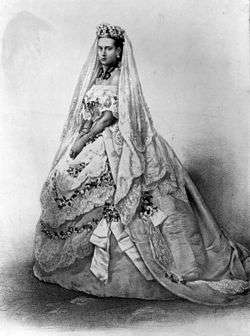Wedding dress of Princess Alexandra of Denmark
 | |
| Artist |
|
|---|---|
| Year | 1863 |
For her wedding to the future Edward VII of the United Kingdom on 10 March 1863 at St. George's Chapel, Windsor Castle, Alexandra of Denmark wore a Honiton lace dress which has been described as "symbolic, echoing long traditions of wedding attire and a fashionable court dress of completely English manufacture."[1] The gown was made by a London dressmaker, Mrs James of Belgravia.[2] It is now part of the British Royal Collection and formed part of a display of royal wedding dresses at Kensington Palace in 2011.[3]
The original design for the dress, using Belgian Brussels lace, was not accepted, with an alternative design made up in English-made lace from Honiton and silk woven in Spitalfields. The lace was worked with emblematic designs of the English rose, the Irish shamrock and the Scottish thistle. It was additionally embellished with garlands made of orange-blossom and myrtle, and was the first Royal wedding gown to be photographed. Images of Alexandra in her bridal gown were flashed across the world.[4]
Design

The dress was made of white satin trimmed with orange blossoms, myrtle and puffs of tulle and Honiton lace. It had a similarly trimmed 21 feet (6.4 m) silver moiré train which was carried by eight young ladies aged 15 to 20.[4][5][5] The lace was designed by Miss Tucker and executed by Messrs. John Tucker and Co. of Branscombe, near Sidmouth, and comprised a suite of four deep flounces with matching lace veil, train trimming and handkerchief. The pattern of the lace depicted cornucopias filled with roses, shamrocks and thistles, arranged in festoons, and interspersed with the same plant motifs.[5] As a wedding gift the Princess had received a suite of Brussels lace for her gown, but in accordance with Queen Victoria's wishes, English-made lace was substituted.[5]
To accessorise the dress and veil Alexandra wore a wreath of orange blossom and myrtle, and carried a bouquet, supplied by Mr. J. Veitch, of orange blossoms, white rosebuds, lily of the valley, orchids, and myrtle.[5] Her jewellery comprised a pearl necklace, earrings and brooch given by the Prince of Wales; an opal and diamond bracelet given by the Queen; another diamond bracelet given by the ladies of Leeds; and an opal and diamond bracelet given by the ladies of Manchester.[5]
Attendants
The bridesmaids were:
- Lady Diana Beauclerk, later Lady Huddleston (1841-1905), wife of Sir John Walter Huddleston; daughter of William Beauclerk, 9th Duke of St Albans.
- Lady Eleanor Cecilia Hare, later Lady Heneage (1845-1924), wife of Edward Heneage, 1st Baron Heneage; daughter of William Hare, 2nd Earl of Listowel.
- Lady Elma Bruce, later Lady Thurlow (1842-1923), wife of the 5th Baron Thurlow; daughter of James Bruce, 8th Earl of Elgin.
- Lady Feodorowna Cecilia Wellesley, later Viscountess Bertie of Thame (1838-1920), wife of Francis Bertie, 1st Viscount Bertie of Thame; daughter of Henry Wellesley, 1st Earl Cowley.
- Lady Georgiana Susan Hamilton, later Countess Winterton (1841-1913), Wife of Edward Turnour, 5th Earl Winterton; daughter of James Hamilton, 1st Duke of Abercorn.
- Lady Agneta Harriet Yorke (1838-1919), later Lady Agneta Montagu, wife of the Hon. Victor Alexander Montagu, son of John Montagu, 7th Earl of Sandwich; daughter of Charles Yorke, 4th Earl of Hardwicke.
- Lady Victoria Margaret Louisa Howard (1844-1906), daughter of Charles Howard, 17th Earl of Suffolk.
- Lady Victoria Alexandrina Montagu Douglas Scott, future Marchioness of Lothian (and later Lady Talbot) (1844-1938), wife firstly of the 9th Marquess of Lothian and later wife of Bertram Chetwynd Talbot (son of John Gilbert Talbot); daughter of the 5th Duke of Buccleuch.[6]
The bridesmaids wore white glacé silk dresses trimmed with tulle netting and roses, and wreaths of roses.[7][8]
References
- ↑ Denney, Colleen (April 2005). Representing Diana, Princess of Wales: cultural memory and fairy tales revisited. Fairleigh Dickinson Univ Press. p. 54. ISBN 978-0-8386-4023-4. Retrieved 30 April 2011.
- ↑ Alexander, Hilary (22 April 2011). "How will The Dress measure up to history?". London: telegraph.co.uk. Retrieved 1 May 2011.
- ↑ Historic Royal Palaces feature, accessed July 12, 2011
- 1 2 "Royal wedding: The lessons and comforts that can be gleaned from previous marriages". The Telegraph. London. 24 April 2011. Retrieved 1 May 2011.
- 1 2 3 4 5 6 The Gentleman's magazine. F. Jefferies. 1863. p. 506. Retrieved 30 April 2011.
- ↑ "The bridesmaids of Alexandra of Denmark". National Portrait Gallery.
- ↑ Mark Bills; Vivien Knight; Guildhall Art Gallery; Mercer Art Gallery (2006). William Powell Frith: painting the Victorian age. Yale University Press. pp. 122–. ISBN 978-0-300-12190-2. Retrieved 1 May 2011. Cite uses deprecated parameter
|coauthors=(help) - ↑ "'The Bridesmaids' by Robert Charles Dudley". National Portrait Gallery.